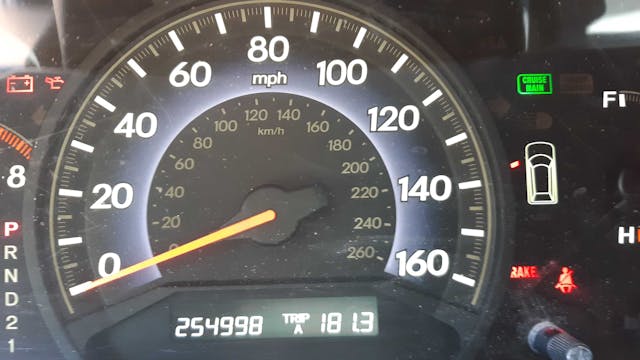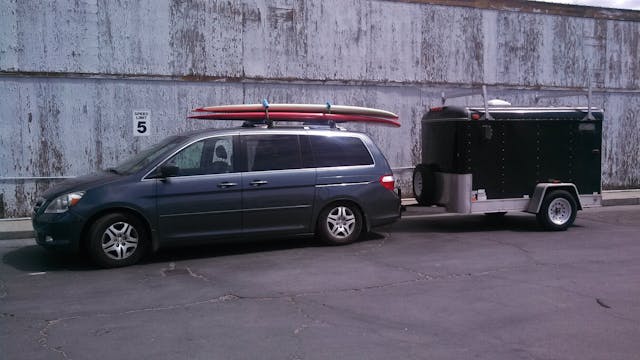Our tame fighter pilot says his van goodbyes
Being a one percenter means a lot of things to a lot of different people. Exact numbers are hard to come by, for obvious reasons, but looking around online it appears we fighter pilots make up about one percent of my branch of the military. That makes me a one percenter, but I also qualify in another way: My total military flight hours are on the order of one percent of 254,998.
***
“Go get dressed!”
Those of us currently serving or who previously served in the Armed Forces have undoubtedly been given some strange orders at one time or another. My strangest? I’d likely choose being ordered to recite the lyrics to “Hit Me With Your Best Shot” by Pat Benatar while standing at attention trying not to stare at the bulging veins in my inquisitor’s neck (don’t worry, I’m a real tough cookie and I nailed it), but being repeatedly told to get dressed and undressed isn’t that far behind.
Among the gear we fighter pilots wear while flying is a g-suit. There are a couple different iterations, but the most common version kind of looks like a pair of chaps. Inside are air bladders that proactively inflate as g-forces build. This inflation and subsequent pressure causes pilots to reflexively tense their thigh, calf, and stomach muscles, thereby keeping blood in the brain. Blood and oxygen flow to the brain are useful for such things as maintaining one’s vision and consciousness, both of which are generally considered to be requirements when flying an aircraft.
In pilot training our instructors would get frustrated at my classmates and me at how long it would take us to put on our flight gear before we walked out to our aircraft. Now that I’ve put my gear on well over a thousand times, the process takes me almost no time at all. I like to think I’m a patient person, but I’ll admit to occasionally wondering what’s taking my fellow aviators so long to put on their crap, particularly when said aviators are still relatively inexperienced, so I can understand why our instructors were frustrated.

Bad weather days were the worst in pilot training (yes, we trained to fly in bad weather, but there are weather limits and when those were exceeded, we remained on terra firma). Not only did it mean no flying, which was the whole point of being there, it also meant our instructors were bored—and the only thing more dangerous than bored instructors are wounded mosquitos. They’d pass the time grilling us on emergency procedures and our general knowledge: How much fuel does the right tank hold? How about the left? Is the Master Caution light powered by AC or DC power? Eventually, they’d tire of quizzing us and it became time for us to entertain them.
Tangent: The thing I dreaded most was flying with a particular instructor during my initial training in a fighter (he sat in the rear cockpit and I was in the front). It’s not that he was a bad instructor, but if we got delayed on the ground he’d tell me to bring up a specific screen on a display, air-to-air radar for example, and he’d go around the display asking me the function of every single button (most fighter jets have displays with some 20 “push buttons” around the outer edge whose functions vary from screen to screen; those were the buttons he’d reference). There are a multitude of possible sensors or systems to display on a screen and he’d have me work my way around each of them until the rest of our formation was ready, the weather cleared, or whatever was causing our delay was resolved and we could takeoff. Brutal.
Our instructors yelling at us to go get dressed both entertained them and taught us to put our gear on faster. We’d run to life support, put on our g-suits, and then run/waddle back to the flight room wearing our “speed jeans.” I don’t recall any particular reward or punishment, but trash talking and bragging rights were motivation enough. About a year ago, many years and repairs since those “go get dressed!” days, the flight equipment shop finally condemned my g-suit as being too threadbare and unrepairable. It fit like a glove, the zippers were like butter, and took roughly 8 seconds to put on. As I aged out of my twenties, the fit had to be adjusted, but it’s impressive the suit lasted as long as it did. Though I’ve finally broken in the zippers on the new one, like a pair of new jeans, it still isn’t as comfortable to me as the original.
Replacing something so familiar doesn’t happen easily, if it at all.

Three days ago was the 16th anniversary of the purchase of our beloved 2006 Honda Odyssey (currently showing 254,998 miles). Twelve days prior to that sweet anniversary, a road trip happened to take us by, for the first time in more than 15 years, the dealership from which we purchased the van. When we last passed the dealer we were in said 2006 Odyssey; this time we were in a new-to-us 2012 Odyssey. We didn’t intend to part with our ’06, but, as with the FJ40, the ’12 fell into our laps and we couldn’t pass up the opportunity. Crazily enough, that meant we bought three cars in three weeks (’22 Miata, ’12 Odyssey, ’68 FJ40).
My buddy Chad and his wife, on whose property the FJ40 sat, have been friends for many years; among other gatherings, our wives get together every Thursday morning and go for a run. One Thursday evening, three days after returning home with our new Miata, my wife, children, and I piled into our LX470 and departed for a long weekend in the woods. As my wife and I talked during the drive, she mentioned during that morning’s run that Chad’s wife had told her they were going to sell their 2012 Odyssey. It had about 133,000 miles, and I knew how assiduously Chad cared for it.
I looked at my wife and asked if she was thinking what I was thinking, and I was stunned when she told me she had no idea. It’s a running joke between us that even after nearly 25 years married, we still frequently stump each other when one of us “jumps” the conversation to a new topic and the other can’t follow. In this case, however, I didn’t see it as a jump at all. I mean, we weren’t in our ’06 Odyssey at that very moment because it needed some work, and here we were, talking about our friends selling their ’12 Odyssey.

Even after I caught her up on my jump, she was initially confused, since we had previously discussed keeping the ’06 van until it died. As we talked through it, I described how well Chad cares for his vehicles, recounted how much we both really enjoy having a minivan (don’t tell my fellow fighter pilots I said that), and reminded her that over the previous year we had put about $2000 into the van. Plus, it currently needed some attention to address a strange clunk around the engine bay I couldn’t figure out. Even in today’s crazy market, it wasn’t worth more than about $3000, but since it also needed a timing belt within the next 2000 miles (previous one was replaced out of cycle when we addressed some other issues), it was probably only about a $2000 vehicle. Spending a vehicle’s value on parts/repairs in a year, to me, is a clear sign it’s time to think about moving on from it. My wife agreed, and she texted Chad’s wife. A couple texts later, the deal was done, though neither my wife nor I had driven it. I hadn’t even sat in it.
Thankfully, since we’ve decided to give our ‘06 to a sister-in-law and her family, this isn’t a bring-out-your-dead eulogy, merely a relocation goodbye, something this military family knows all too well. That said, the ’12 will see duty as a kid’s car, replacing a recently-totaled kid’s car, so this may turn into a eulogy sooner rather than later.

The rapid purchase and subsequent moving on from the ’06 Odyssey surprised our older kids (three are out of the house). They’ve spent large portions of their lives in that van. Our 20-year-old, who lived in 14 different houses before graduating from high school, said the van was the one physical constant in her life outside of family. We have a map of the United States hanging on our wall. On it we’ve marked every major road my wife and I have driven on together, with a dot where we’ve spent the night and a star where we’ve lived. Those lines cover 45 of the lower 48 states, and the vast majority of the miles indicated were spent in that van. I can’t help but agree with our daughter’s sentiments.
We decided to do one last road trip with it. However, while driving the new van the 25 (mostly freeway) miles home I saw that it was getting about 27 mpg, something our OG van likely hadn’t achieved in 100,000 miles. (20 mpg is about the best it can do these days; EPA rating was 28 highway when new.) I don’t need to tell you that on a 1900 mile road trip with the stupid present-day gas prices, 27 mpg presented significant cost savings over 20. A long final road trip for us and the van wasn’t to be.
It was strange driving the 2new12 van. On the one hand, it was very familiar; on the other, something just wasn’t quite right. It reminded me of watching a YouTube video in which a favorite song is played in a different key.
Some differences were subtle: The first time my wife and I held hands across the center console it felt different; turns out the new van is 2 inches wider. The trim piece bleached white from a hand-sanitizer spill during spring break 2014 is absent. The cruise control on/off button doesn’t have a piece of a paperclip wedged in it to keep it in the “On” position. Nalgene water bottles don’t fit as well in the doors as they did in the old van’s.
Other differences were more obvious: The aforementioned gas mileage. The console between the front seats is no longer just a shelf; there’s now a cavernous storage area under it. Bluetooth means we no longer need to run a headphone jack cable to the aux input in the rear. The rear door (hatch?) closes at the push of the button, though I’m not convinced I like it more than just burning some glycogen. The check-engine light doesn’t come on after a couple hours cruising on the freeway.

I think what bugs me most about it are the clear signs of de-contenting—and the newer van is a higher trim level! The DVD player doesn’t play Blu-Ray (in fairness, neither did our old van’s, but considering Blu-Ray was brand-new when we bought the OG van, it’s excusable; the six-years-newer van has no excuse). The drawer that was under the front-row passenger seat is now just a vacant space; it was the perfect size to store a power inverter. The spare tire now takes up the under-the-floor storage space that was great at holding tools, tow gear (pin, ball mount, and ball), and air compressor. That said, I can’t blame Honda for this; the new van does have a tow hitch, but its misleading Hidden Hitch name belies its significantly lower mounting point. We’ve already scraped it on a few parking lot exits.
***
In my advanced age (years of military service, not birthdays), I don’t foresee having enough flying left that would enable my new g-suit to reach the fully broken-in stage. Don’t get me wrong—it works fine, and I’m grateful it keeps me from taking an ill-advised airborne ischemic catnap, but it will only ever be a functional piece of equipment to me and nothing more. The new van is similarly fine; it gets us from Point A to B with no drama. But there’s no there there. Like 99 percent of the populace, which views cars as appliances, that’s all it is for us. I’ll admit we’re still breaking it in, and it’s unfair to expect to the same connection with a vehicle we literally drove to the moon over 16 years as with one we’ve put some 3000 miles on in a few weeks, so there’s still hope. Maybe it’ll help if I blast some Pat Benetar while driving it.


